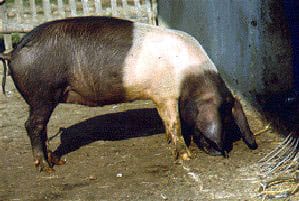Type the name of the breed you're looking for below
[wpdreams_ajaxsearchlite] Don't see the breed your're looking for? Click here and let us know!
Krskopolje pig
| Place of Origin | New Zealand |
| Origin | The kunekune is a small breed of domestic pig from New Zealand. Kunekune are hairy, with a rotund build and may bear wattles (or piri piri) hanging from their lower jaws. They have a docile, friendly nature, and – like the pot-bellied pig – are now often kept as pets. The kunekune is believed to have descended from an Asian domestic breed introduced to New Zealand in the early 19th century by whalers or traders. They differ markedly from the feral pig of European origin known in New Zealand as a "Captain Cooker". The native Māori people of New Zealand adopted kunekune: the word kunekune means "fat and round" in the Māori language. Rarity By the 1980s, only an estimated 50 purebred kunekune remained. Michael Willis and John Simister, wildlife-park owners, started a breeding recovery program, which in turn encouraged other recovery efforts. As of 2010, the breed no longer faces extinction, with breed societies in both New Zealand and the United Kingdom. |
| Purpose | Pet |
| Characteristics | Appearance The kunekune is covered in hair which can be long or short, and straight or curly. Hair colours include black, brown, ginger, gold, cream, and spotted combinations. It has a medium to short snout, that is black and either semilopped or pricked ears. It has a short, round body with short legs and two tassels (called piri piri) under its chin. The kunekune stands about 60 cm (24 in) tall, making it one of the smallest domesticated breeds of pig. An adult kunekune can weigh between 60 kg (130 lb) and 200 kg (440 lb), well below the 400 kg (880 lb) of commercial pigs. Personality Kunekune are suitable for a novice owner, as they are placid, friendly, and love human company. They are intelligent and easy to train. Habitat The natural habitat for kunekune is woodland and pasture. They love being outdoors and are suitable for a range of climates, in addition to being ideal for large gardens. For keeping them as pets, it is best to buy an arc (a house for the pigs) at least 2 m in size, depending on the number of pigs. Diet Kunekune are very easy to manage as they have the ability to fatten on little more than grass. They are the only true grazing pig and can be maintained with grass alone without supplementary feeding. An acre of grass can sustain as many as 5 kunekunes. Breeding Kunekune boars are fertile at 6 to 7 months and the gilts can become pregnant at 5 months. However, gilts are not normally put to the boar until they are a year old. The sows are good mothers and the litters vary in size averaging around seven piglets. |



